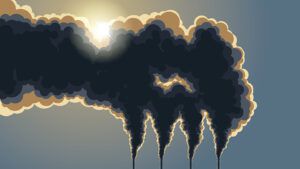The top 50 greenhouse gas emitters in Asia Pacific have broad climate ambitions, but this is not quite matched by action taken so far, according to Barclays’ research team.
Its recent study, The Asia 50: Biggest corporate emitters can improve on climate actions, looked at the 50 largest greenhouse gas emitters in the region among listed companies. The 50 firms account for about 20% of the region’s energy emissions.
“Most of the companies have shown strong commitment by setting climate targets, but there is clearly room for improvement on target refinement, capital alignment, executive pay linkage and clarity of carbon strategy,” the study said.
The study found that 76% of the 50 companies have given net-zero targets with average timelines four years earlier than average national targets (2055 as opposed to 2059).
However, while all mention transition as their key climate action, most are budgeting less than 20% of their planned capital expenditure for transition investments.
The region’s power and energy companies show the largest gaps compared with the leading global peers in these sectors when it comes to capex, while steel and cement are closer to the global average.
Meanwhile, 64% of companies have already set up a board-level ESG committee in parallel with other committees such as audit, remuneration and nomination, but only 46% have ESG-linked compensation for senior executives.
The study measured the 50 largest publicly-listed companies in Apac by reported emissions (both Scope 1 and 2). It then introduced a screening process to quantify companies’ climate action profiles, which includes targets and transparency of targets among other things.
The study found that the leading companies are CLP Holdings, Sembcorp Industries and Baosteel. Unsurprisingly, more developed markets like Hong Kong and Singapore are generally ranked higher.
However, China made up 38% of the companies on the list followed by India at 18% and Japan and Australia both at 8%.
By sector, power is the largest industry at 26% followed by steel at 20%, cement at 18% and energy at 14%.
The Apac region generated close to 40% of global GDP in 2021 but consumed 80% of coal usage globally and contributed 51% of the new CO2 added to the earth’s atmosphere, according to the study.
The survey also asked corporates whether they plan to have their emission targets verified by third-party agencies like the Science Based Target Initiative.
Based on the 22 responses they received, only two companies are already verified and just eight have a plan to get verification sometime down the road.
